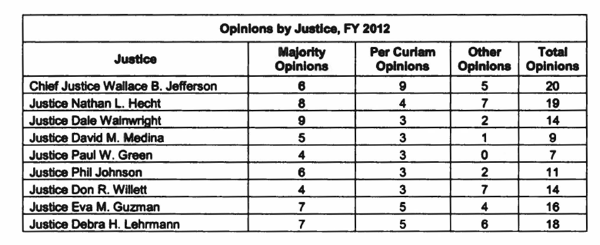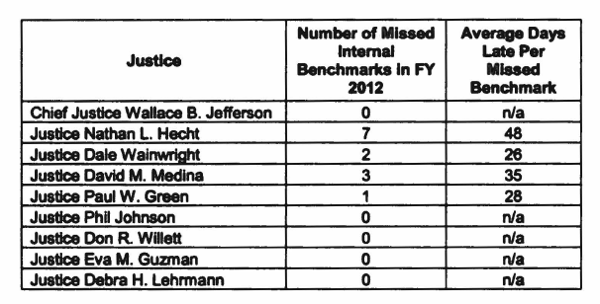Last fall, I mentioned in passing the Legislature’s new requirement that the Court compile and submit a report about how each Justice has met the Court’s internal operating deadlines.
The Court has released the 2012 version of this report. (( I do not recall seeing a public release of the 2011 version, which would likely have been due the same day that I wrote that blog post mentioning it. ))
It includes the usual information, such as that only seven argued cases were carried over in August to the new fiscal year that started in September (the same count I reached here), (( As of today, all seven of those remain pending. They are the cases that (today) are highlighted on my list of outstanding argued Texas Supreme Court cases. You can click on the “Date Argued” heading to resort that list. )) as well as a breakdown of how many opinions each Justice wrote:

As with the OCA reports, this reveals the count of per curiam opinions authored by each Justice. Last year, there was only one outlier. The Chief Justice wrote 9 per curiams, with the other Justices all writing between 3 and 5 per curiam opinions.
The new glimpse into the Court — the one demanded by the Legislature — is the “Number of Missed Internal Benchmarks” chart, broken down by Justice:

For 2012, five of the Justices had a perfect score on the internal benchmarks. The outlier was Justice Hecht, who was recorded as missing seven of them. (( For fiscal 2011, only two Justices met all the benchmarks. ))
For context, the report emphasizes that “the missed benchmarks did not hinder the Court’s or any Justice’s output in fiscal 2012. Of the thirteen benchmarks missed, only two items remained outstanding at the end of the fiscal year.” (page 3)
The Court and the Legislature
It is hard to read the report without thinking about the larger questions of the Court’s relationship to the Legislature. In the past, the Legislature has shown interest in why the Court’s decisions can take time, culminating in this more detailed reporting requirement.
And since the last legislative session, the Court has tangled with several direct actions brought under a special statutory provision requiring a decision within 120 days. In the first of those, In re Allcat Claims Service, L.P. and John Weakly, No. 11-0589 , Justice Willett’s separate opinion (joined by Justice Lehrmann) raised separation of powers concerns about that time limit and about legislative intrusions into the internal processes of the Court.
The language here is not so direct, but it does offer pragmatic reasons why particular deadlines might be missed in pursuit of “thorough and accurate declarations of law.” (page 2) The Chief Justice’s concluding paragraph promises that, “[i]n the coming year the Court will continue to handle cases efficiently, but not prematurely.” (page 4)



2 responses so far ↓
1 Franklin Bynum // Nov 29, 2012 at 12:23 am
Is the Court of Criminal Appeals required to produce a similar report?
(The link in the older post is dead.)
2 Don Cruse // Nov 29, 2012 at 5:56 am
No, I don’t think the CCA is required to produce anything similar.
The relevant language from the appropriations bill is this:
Thanks for pointing out that the link to that bill has broken. It can now be found here, with the relevant language still on page 3. The CCA is given some performance goals (as is each intermediate court of appeals), but it is not asked to prepare a separate report.